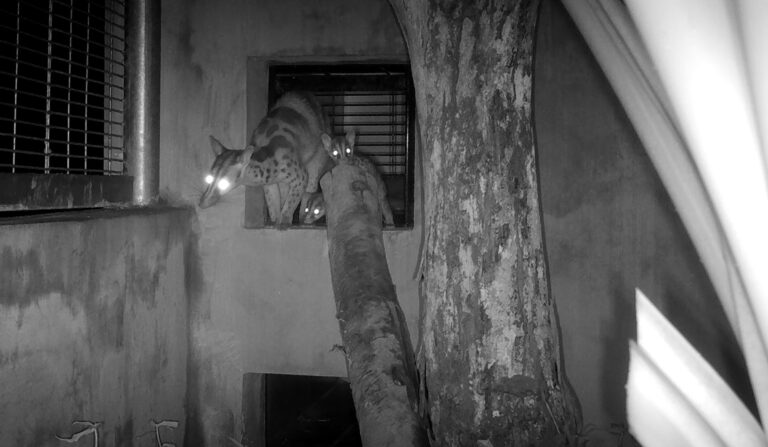Currently, the number of wildlife species in Vietnam is decreasing dramatically. There are 745 endangered species in Vietnam, including “64 mammals, 53 birds, 70 reptiles, 45 amphibians, and 96 fish species” (According to IUCN, 2020, quoted from VietnamPlus, 2021). In addition, many species have fallen into an extremely endangered state, with a very high risk of extinction in the wild such as Tiger, Leopard, Bear, Elephant, or some primates and many other species; there are even species that have actually disappeared from the map of Vietnam such as the Javan rhinoceros (According to WWF and IRF, 2011). The root cause of the problem is the lack of information as well as the indifferent attitude towards wildlife of many people in the society, which lead to harmful actions and behaviors to wildlife.
The article “Journey from the forest to the drinking table” will provide readers with more information about an extremely dangerous and painful journey that hundreds and thousands of wild animals have to endure in their own natural home, in order to serve unwarranted human needs! During the journey, the pain that wildlife have to endure will be highlighted, from being hunted in the forest, to being transported to consumption places and end up being sold for many different purposes.
Hunting: the nightmare of wild animals in the forest
Hunters do not hesitate to use all kinds of hunting methods to hunt and kill animals, and then sell them to illegal wildlife traders. The most common method is using traps, shotguns, electric pulse fishing, and hunting dogs.
Among all the types of traps that hunters often use, snare trap is the most common type. Snare traps made from ropes were commonly used for hunting in the past, and wild animals could bite the ropes off to escape. Nowadays, hunters prefer homemade snare traps from bicycle brakes as they are lightweight, cheap, easy to make and carry along. This is one of the most dangerous kinds of traps, as the chance of escaping for animals is approximately zero. Once trapped, wild animals have no choice but to helplessly suffer until they die.
There are 4 types of snare traps: Single traps that are set up throughout the forest, Snare traps that are set up on tree trunks and carefully camouflaged, Combination of multiple single traps to create a fence around trees where animals often come to find food, Combination of different snare traps, which can run for several kilometers in the forest.
In addition to homemade snare traps from bicycle brakes, hunters also use a wide variety of animal traps, including: Trapping pits, Body grip traps made from wood or bamboo, Body grip traps made from iron, Foothold traps. In particular, foothold traps are extremely terrifying as the trapped animals are severely injured; they may lose their legs or even their lives due to injuries caused by the traps.

Bicycle brakes

Snare trap
In addition, hunters also use shotguns, electrical impulses and mines to kill animals. Shotguns, specialized guns or improvised guns are highly lethal. Not only do they take away the lives of wild animals but they can also accidentally kill those who use them. Besides, using electrical impulses and mines is also extremely dangerous for both animals and humans. This is regarded as destructive fishing methods. Not only fish but millions of aquatic creatures are also killed, the fishery resources cannot reproduce. Electrical impulses leave negative impacts on human nerves, destroy red blood cells and even cause death.

Shotguns
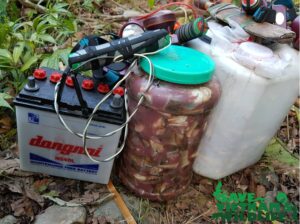
Electrical impulses and mines
Beside all the hunting methods mentioned above, to increase the ability to search and detect wild animals, hunters also use hunting dogs to help find animals. Hunting dogs are hunters’ helpful assistants. With their superior sense of smell and route detection ability, incredible chasing speed and even the ability to attack animals, they become the enemies of wild animals in the forests.
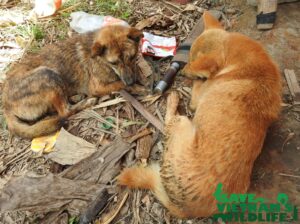
Hunting dogs
Transporting: the endless torture for wild animals
After catching animals, hunters and illegal traders will find ways to take animals out of the forest for consumption. Wild animals are smuggled out of the forests by many different means of transportation to avoid the anti-poaching force. After getting out of the forest, animals continue to be hidden and disguised inside cars. These cars use longer routes with many stopovers to avoid law enforcement officers.
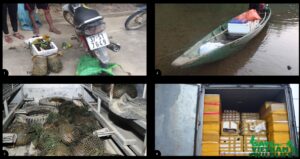
Mean of transporting wildlife
In order to improve profit, hunters and illegal wildlife traders use many methods to increase animals’ weight, such as force-feeding animals with unknown fluids, or even cruel things like powders, stones and plastic products. Animals are often stressed, injured, suffocated with no food or water, so they can easily die from exhaustion. Dead animals are kept frozen when transporting to prevent decomposition and odors.
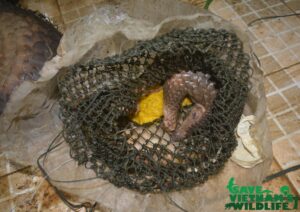
Increase animals’ weight
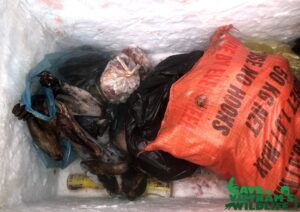
Freeze animals
Once safely transporting wild animals out of the forest, the traders continue to find ways to sell animals, and restaurants specialized in wild meat are their familiar destinations. Here, wild animals continue to be mistreated, as they are kept in cramped, unsanitary cages, having to eat food that is not suitable for animals, and even being starved, waiting for customers to order them.
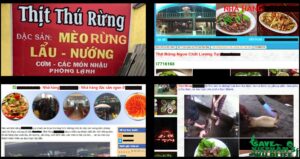
Selling animals at restaurants
Online advertising and shopping: a way to “speed up” the journey for animals to end up on the “drinking table”
Advertisements of restaurants that sell illegal wildlife meat still appear publicly in many places, as the fine from 1 million to 1.5 million VND for wildlife crime is not high enough to discourage them. This creates favorable conditions for hunters and traders to distribute their illegally hunted wild animals. At the same time, it is easier for consumers to access and buy wildlife products. Therefore, the risk of wild animals being illegally hunted, trafficked and consumed is made higher.
In addition, online selling on social network platforms is growing and leading to a rise in online wildlife trade, from quiet and private transactions to public ones that are challenging governmental authorities. This form of trade is very easy for consumers to access, therefore increasing their demand, and it is at the same time difficult to track and collect evidence, making it harder for the authorities to manage, control and punish violators.
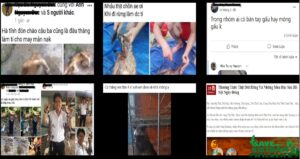
Selling animals by online
The “drinking table”: wildlife are used for many purposes
After being captured from their own home and transported out of the forest, wild animals will be used for many different purposes, and the most common being meat, wine, medicine, pets, jewelry, decoration… According to the social research results report of WAR in 2011, wild animals being used for food were the most common. Many people still believe that being able to afford expensive meals that are made from wildlife products will prove their high status and wealthiness, making it easier to form business relationships on the dining table, they are willing to defy the law and put their health, or the risk of disease transmission from animal, still to continue to use products from wild animals.

Using wild animals as meats
Next, using wild animals to make wine and traditional medicine is also popular in Vietnam and some other Asian countries (According to many domestic and international tourists). Many “masculine” men in Vietnam have paid a huge amount of money to get wine in which wild animals’ parts were steeped in, in order to enhance their sexual performance. As the result of this inaccurate and unjustified belief, many people are hospitalized after drinking these wines.

Using wild animals as wines
In addition to the mention-above belief, there are also quite a few people who still choose to treat diseases with traditional medicines made from wild animals. Traditional medicine takes more time to work than Western medicine, so for advertising, many people have spread rumors that traditional remedies using wild animals can cure all kinds of diseases. These non-scientifically proven word-of-mouth have stimulated demands for wild animal products as medicine. Oriental medicine made from rare species being on display means that thousands of Bears are imprisoned in narrow iron cages for daily extraction of bile, tens of thousands of Pangolins are slaughtered and descaled every year, millions of Rhinos are hunted to the point of extinction for only their horns, etc. This has pushed many animals to the brink of extinction. All of these things can be easily avoided by using medicinal plants and substitutes for wildlife products.

Using wild animals as traditional medicines
Also, nowadays keeping wild animals as pets is becoming a dangerous trend, threatening many rare species such as Otters, Wildcats, Langurs, Monkeys, Lizards, etc. Very few people know that hunters have to kill the parents, or sometimes the whole herd just to steal the younglings. Baby wild animals raised in domestic environments will be susceptible to diseases that are hard to be treated by conventional veterinarians. Furthermore, animals still have their wild instinct and can injure the owners, or transmit infectious diseases to humans and other pets in the family.

Using wild animals as pets
What can we learn from the journey of wild animals?
The journey from the forest to the “drinking table” of wild animals has provided readers with information and multi-dimensional perspectives on the causes of the decline of wildlife species in Vietnam in particular and the world in general, as well as the disappearance of many species. Readers can understand more about the threats as well as the extreme pain that wild animals are still suffering every single day in their own natural home, caused by illegal hunters and traders and especially customers who put their selfish needs before others.
However, it must be stated once again that people who use wildlife products are actually losing more than getting. For example, they can be fined or even imprisoned; they can lose their reputation from using wild animal products; or they can suffer from infectious diseases or even death just because of their belief in medicines made from wild animals. Their actions will affect not only themselves and their family, but also their own country and the whole world! If these activities of wildlife hunting, trading and consumption continue, it means that many people still have to live a poor life , unable to escape the vicious circle of poverty. Social security is not guaranteed because of the severe pandemic.
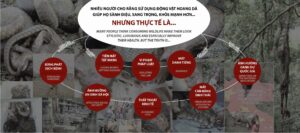
Consequence of using wild animals
Therefore, SVW wants to send you a message: Be a wise consumer, for your family and for society! Join hands with SVW to protect wildlife by saying no to the illegal hunting, trading and using of wild animals and all wildlife products! For all Vietnamese people to live a healthier life and Vietnamese wildlife to live a free life in their own natural home.
Join SVW at: https://svw.vn/get-involved/



